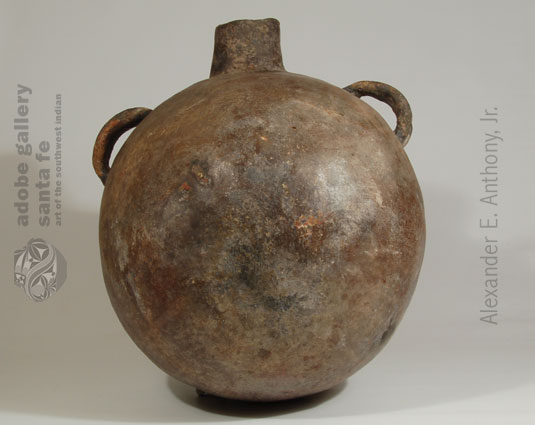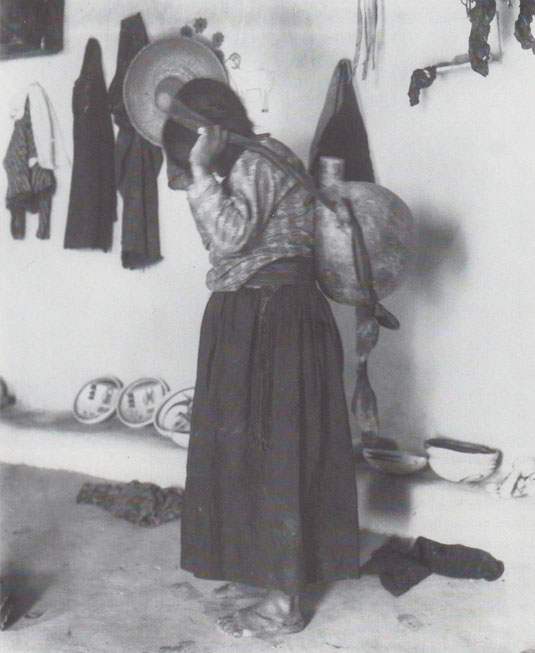Historic Hopi Pottery Canteen for Snake Dance Ceremony [SOLD]
+ Add to my watchlist Forward to Friend
- Category: Historic
- Origin: Hopi Pueblo, Hopituh Shi-nu-mu
- Medium: clay
- Size:
14-1/2” front to back;
12-3/4” width; 10-3/4” height - Item # C3942A SOLD

Just as the dawn approaches on an August morning, groups of villagers eagerly watch for the approach of the young racers. Just as the sun rises, the winner of the race passes over the roof of the Snake Kiva and the day of the Snake dance has begun.
In the kiva, the snake priests are bringing to a close the mysterious rites begun days before, when the Sun priest had directed the town crier to announce the commencement of the ceremony. Since that time, the priests had descended in to the kiva, and a fleet runner had each carried plumed prayer sticks to the distant springs and shrines. Four days to the north, west, south and east snakes had been hunted. Then came the Antelope dance on the evening before the Snake dance; the sixteen songs and drama were enacted in the kiva while the Snake race was being run, and the time is now ripe for the final spectacle.
The snakes have been washed and placed in jars and the costuming begins. In every historic photograph of the interior of the Snake kiva are seen large canteens such as this one presumably from which the snakes have been washed and in which they have been placed before transport to the plaza.
These large canteens are rarely available on the market. There is no restriction on their being sold but rarely does one see one for sale. They always are, like this one, undecorated. They are just in the earth-color clay from which they were made. The spout is just slightly above ground when the canteen is resting on its base, an indication that this is not a water canteen for normal use. This appears to be a late 1800s canteen.
Condition: very good condition with no repairs
Provenance: from a gentleman who collected this one decades ago who now lives in Colorado
Recommended Reading: The Moki Snake Dance by Walter Hough. An Avanyu Publishing re-print of this is available from Adobe Gallery in limited numbers.
Image Below: “Nampeyo carrying an olla” Adam Clark Vroman, 1901. (The Southwest Museum, Los Angeles. Photo #N22764.) Nampeyo posed for Vroman inside her home with a typical canteen carried by women to carry water from the spring below the mesa. Photo part of public domain.
Note about copyrights concerning photography: All works published in the United States before 1923 are in the public domain. Works published after 1922, but before 1978 are protected for 95 years from the date of publication. If the work was created, but not published, before 1978, the copyright lasts for the life of the author plus 70 years. It's still the accepted custom or courtesy to give credit to the source and photographer (if known).
As mentioned above, Adam Clark Vroman photographed Nampeyo in 1901 with a large water canteen on her back with a strap over her forehead. Some days, she made four trips down the mesa to the spring for water. This canteen at the gallery is like the one photographed with Nampeyo. Its empty weight is 12 pounds. Filled with water, it weighs 29 pounds.

- Category: Historic
- Origin: Hopi Pueblo, Hopituh Shi-nu-mu
- Medium: clay
- Size:
14-1/2” front to back;
12-3/4” width; 10-3/4” height - Item # C3942A SOLD



